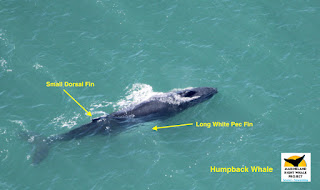 The humpback whale that has caused our phones to ring over the last several days was finally captured on camera. Photographer Tony Caruso of Flagler Beach sent us images he took on 24 Jan. at 11:30 AM from N 23rd St. One example is shown here.
The humpback whale that has caused our phones to ring over the last several days was finally captured on camera. Photographer Tony Caruso of Flagler Beach sent us images he took on 24 Jan. at 11:30 AM from N 23rd St. One example is shown here.
Yesterday, 25 January, following on a call from Team 4 in Ormond-by-the-Sea, the Air Cam crew spotted it as well, about a mile and a half east of Flagler Pier. The whale was surfacing briefly and intermittently, and observer Terry Clark caught it just before the Air Cam flew past it. The humpback was swimming steadily northbound and the plane circled for nearly 20 minutes before Terry obtained enough photos. Below is one with the distinguishing characteristics highlighted.
Along with the humpback, the Air Cam crew also observed several manta rays breaching, which have also caused the phone to ring. This behavior involves the large rays hurtling out of the water, flipping headfirst upside down, and hitting the water on their backs, resulting in a very large and dramatic splash. The black back followed by a quick glimpse of the white belly has inspired many people to report that they saw a whale. Manta rays normally reach our survey area in late March or early April, after right whales have migrated north, and when ocean temperatures have warmed. The Air Cam documented the rays from Ormond Beach to Flagler Beach, something to keep in mind as you are surveying!






